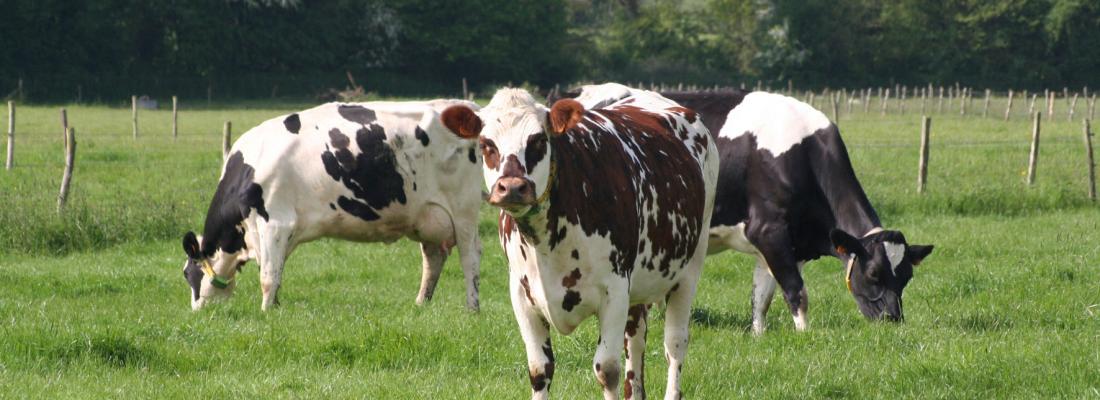Agroecology Reading time 3 min
When cattle chromosomes get tangled: detecting genetic defects to better prevent them
Published on 07 July 2023

Interchromosomal rearrangements are exchanges of genetic material between two chromosomes that are not part of the same pair. They usually appear at the time gametes are formed. In the vast majority of cases, such anomalies lead to early death of the embryo. In other cases, chromosomal rearrangements can have severe pathological effects, as has been shown in humans. All animals, whatever their sex or race, may be affected, whether or not they are breeding stock. The widespread use of animal insemination causes bovine populations to be particularly at risk from the hazards of mass distribution of the semen of healthy carrier sires not affected themselves by such mutations. However, up to now, no large-scale analysis has been done to study the prevelance of interchromosomal rearrangements, their origins and their impact on animals and the cattle sector.
Genetic analysis out on 5571 bulls and their 2 million offspring, from 15 breeds
The study examined 5571 bulls from 15 breeds for a total of more than two (2) million individual progeny. For their analysis, the geneticists used 50,000 genetic variants that set out the genome of each offspring. These markers are routinely used as part of genomic evaluation of breeding stock. The researchers screened billions of possible combinations of pairs of different chromosome markers to see if there were any instances of preferential transmission that would indicate the existence of a interchromosomal rearrangement. They also estimated the effects such anomalies have on the health, survival and reproductive traits of offspring using the millions of data points about their characteristics recorded in French animal breeding databases.

1 sire out of every 450 may be a carrier of such chromosomal defects
Their work made it possible to identify 12 interchromosomal rearrangements, some of which had never before been described in bovines. Such defects would affect about 1 in every 450 bulls. Transgenerational tracking of rearranged chromosomes revealed that most often they had been the result of spontaneous rearrangements during gamete formation in the sires (10 times out of 12). Ten of the bulls with interchromosomal rearrangements had been classified among the least fertile of their race, and the progeny of one of them showed a record-breaking juvenile mortality rate, with 44% of the heifers dying before the age of one. In most cases, analysis of the animal breeding data of those offspring that had inherited the anomaly showed stunted growth and lower fertility in comparison to those heifers with normal chromosomes from the same sire. The researchers estimated that, on average, one or two insemination sires would be affected by such defects each year in France. In each case, dissemination of their semen would cost more than EUR 1 million due to excess mortality and decreased fertility and productivity in their offspring. To solve that problem, these scientists have recommended wide-spread use of prevention methods such as karotyping bulls, i.e. studying the structure and number of their chromosomes. They highlighed the importance of also using the approach developed during this study, i.e. using genetic marker data, to contribute to systematic, wide-spread screening for chromosomal rearrangements. This method is readily applicable to any animal or plant popuation that benefits from large sets of genotype data, with direct agricultural applications.
Reproduction in cattle farming
A straw is a tiny tube that contains one bull's semen and is stored in liquid nitrogen at -196°C. When the time comes, the straw will allow insemination of a cow that lives kilometers away from the bull. Ib this way, all breeders can have access to the best breeding stock, that is to say those whose offspring will be healthy, resistant to infections and will produce good quantities of high-quality milk or meat. Such sires are selected on the basis of their genetic value. The best will have their straws distributed in hundreds or even thousands of copies. Each year about 600 bulls are added to French catalogs (out of a total of more than 6000 bulls used). In dairy breeds such as Holsteins, Montbeliardes, Normandes, nearly 90% of cows are inseminated, as are about 20% in beef breeds such as Charolais or Blonde d’Aquitaine.
Reference
Jourdain J. et al. Large-scale detection and characterization of interchromosomal rearrangements in normozoospermic bulls using massive genotype and phenotype data sets. Genome Research, 33, YYY-ZZZ https://doi.org/10.1101/gr.277787.123
The work that led to publication of this paper was carried out as part of the thesis of Jeanlin Jourdain, a PhD student, for Eliance at UMT (joint technology unit) eBIS. This thesis is being supervised by Aurélien Capitan. It is carried out as part of a CIFRE (ANRT) convention and has joint funding from APIS-GENE. This study also benefitted from work carried out as part of the Effitness and Fertiligest (APIS-GENE) projects and SeqOccIn (FEDER-FSE MIDI-PYRENEES ET GARONNE 2014-2020 and APIS-GENE).
